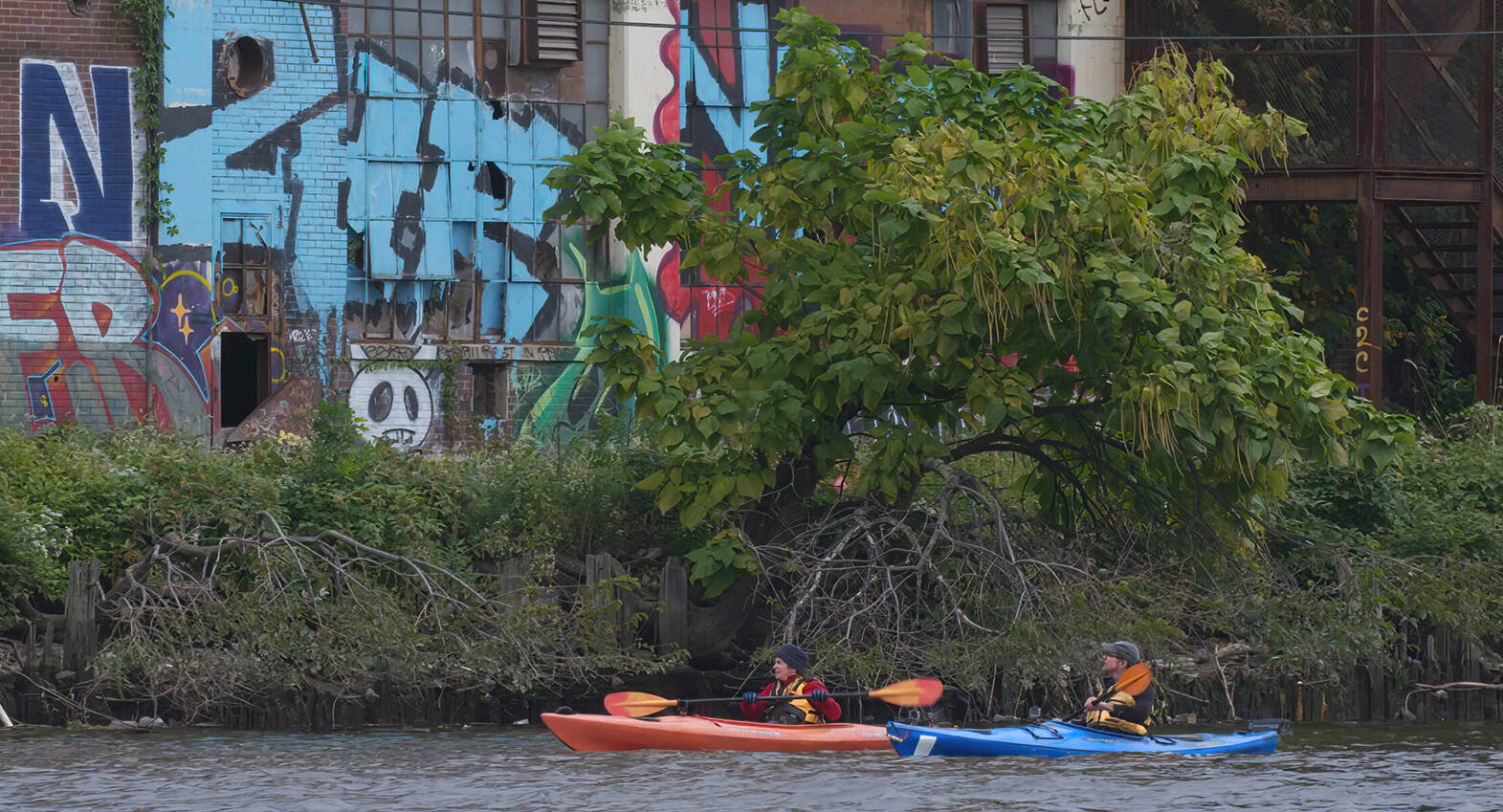When Vashon author Mary Bruno and New Jersey filmmaker Scott Morris take the stage at Vashon Center for the Arts on April 2 to screen and discuss “American River,” audiences will have access to two distinctive artists, each in their creative prime, as well as a winning creative partnership comprised of near-strangers when the project was launched.
“Initially, it felt like a rather audacious thing to do,” Scott Morris said, speaking by phone last week from his home in New Jersey.
The year was 2018, and Morris had recently written and directed a successful one-hour New Jersey conservation story called “Saving The Great Swamp: Battle to Defeat the Jetport” for American Public Television, and he and his funding partner were looking for another environmental-themed project.
Morris had a copy of Bruno’s “American River” at hand, and as he carefully read her story of kayaking New Jersey’s blighted Passaic River, he grew more and more convinced he could film it. Despite the hybrid nature of her tale – part personal history, part environmental science — Morris knew it would work, as long as it featured Mary.
Bruno was glad to talk with Morris when he called for a meeting. “I assumed he wanted me to be a consultant,” she said, speaking from her home on Vashon this past week.
Instead, when Morris asked her if he could adapt her book for film, shooting her in a re-creation of her 2008 kayak trip, Bruno was shocked, but game. Her only requirement was that her original paddling partner, Carl Alderson, a New Jersey river guide and restoration ecologist, be included as a second featured actor on the shoot.
The film, like Bruno’s book, is anchored by the writer’s 80-mile kayak trip from the upper reaches of the Passaic River down to its gaping tidal outflow amongst the steel towers of dark, industrial Newark. On-screen, in the new film, Bruno’s voice grows serious when she explains that Alderson is not just a companion.
“Carl is my Courage,” she says.
Bruno’s childhood conditioning towards the Passaic created lasting terror for her. “We didn’t dare go near the river,” Bruno explained. “Ever.”
Growing up in North Arlington, 12 miles upriver from the city of Newark, Bruno was forbidden to play anywhere near the water. Maltreated and abandoned as its more than 200-year manufacturing history wound down, the neighborhood riverbed was known to be saturated with toxic waste.
And yet, downriver, during Bruno’s childhood, things got even worse. One enormous fertilizer manufacturer was still dumping illegal waste into the water, charting the river’s irreversible course from a “mere toxic dump” to an EPA Superfund site.
Trained for so long to turn their backs on the river, New Jersey natives have flocked to festival showings of “American River” over the last year, eager to gain a comprehensive portrait of their significant home state waterway.
Alderson is one of the rare few who holds practical knowledge of their Passaic route. A long mercurial paddle, the Passaic had no guidebooks, no signage (marking sewage outflows or approaching weirs) nor any marked public access points for put-ins and take-outs.
On the page, Bruno’s own knowledge of the river’s nature and history arises from a wild intelligence that the film just cannot capture. Comprised of patient observation, fascinating research and unexpected personal associations, her descriptions land with an indelible specificity.
Describing the physics involved when a river runs crookedly, a situation that creates a differential in water speed that leads to a constant scouring of the outer bank walls, Bruno herself suddenly veers hard into her own New Jersey childhood.
“When a river rounds a bend, the water moves faster on the outside, or concave side of the meander. It’s like my Girl Scout troop marching in North Arlington’s annual Memorial Day parade. Every time we had to negotiate a curve or a corner in the parade route, the Scouts on the outside had to march a lot faster than the Scouts on the inside in order to keep our parade lines straight.”
During his interview, Morris bemoaned the fact that he couldn’t include more of Bruno’s personal history when the story moved to visual storytelling on film. “There was so much more I wanted to tell about Mary,” he said.
Instead, he worked meticulously to capture images for the screen that synthesized the power of the book’s descriptions of nature.
Selecting a single shot of the Watchung mountain range for the film — to stand in place of a page-long description in Bruno’s book that begins “three parallel ridges pitched in a northeasterly direction and curved like sly smiles” — Morris played with Google Earth at length until he finally found a satisfying presentation of those three ridges.
Calculating that he could get that exact shot from a drone launched 240 feet above a residential street in Clifton New Jersey, Morris dispatched director of photography Roger Grange to bring back a shot that presented that precise, jagged view.
This effort to capture tone and feeling in a singular, lasting image — a shared goal of author and filmmaker on this project — echoes a statement about the future of environmental reporting that David Rains Wallace wrote back in 1983. For the field of nature writing to succeed, Wallace wrote, you need “Somebody to translate scientific information into feelings and visions.”
“American River,” one lucky project, has scored at least two of those visionary somebodies at the helm. And now Vashon, one lucky island, gets its own first-hand chance to see, feel, and discuss in tandem.
The Vashon premiere of “American River” screens at 4 p.m. Sunday, April 2, at Vashon Center for the Arts. Tickets are $25/22/20, with youth under 18 admitted free. Purchase tickets at vashoncenterforthearts.org.


